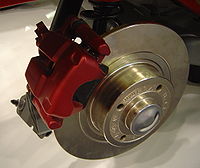
Photo from wikipedia
Abstract Work boots featuring design elements implemented to protect the foot and lower limb are common in many industries. However, boot design can have negative unintended consequences such as increases… Click to show full abstract
Abstract Work boots featuring design elements implemented to protect the foot and lower limb are common in many industries. However, boot design can have negative unintended consequences such as increases in work related fatigue and injury risk. This study compared joint kinematics and the physiological cost of two commercially available steel-toed work boots with different shaft designs worn throughout a simulated work task. A boot with a lower-cut and scalloped shaft allowed greater sagittal plane range of motion at the ankle joint compared to a boot with a higher-cut straight shaft, particularly in the late stance phase of the gait cycle. This was coupled with a decreased physiological cost of treadmill walking (2.6 and 3.1% improvement in oxygen consumption and walking economy, respectively), likely caused by a more efficient gait pattern. A lower-cut and scalloped shaft could lead to decreases in work-related fatigue and the subsequent risk of injuries in workers. Practitioner summary: Gait kinematics and the physiological cost of work boots with different shaft heights has not previously been investigated. A randomised cross-over study design found that a boot with a lower shaft height and scalloped collar improved ankle range of motion and reduced the physiological cost experienced by the wearers. Abbreviations: ROM: range of motion; FS: full shaft; SS: scalloped shaft; COM: centre of mass; HR: heart rate; RPE: rating of perceived exertion; ES: effect size.
Journal Title: Ergonomics
Year Published: 2020
Link to full text (if available)
Share on Social Media: Sign Up to like & get
recommendations!